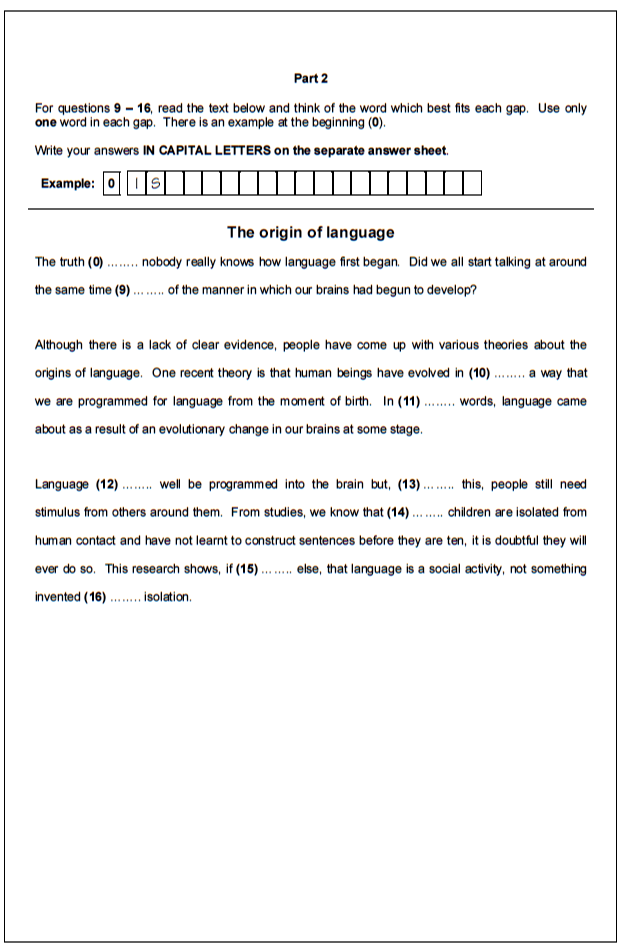Are you taking the Cambridge CAE or FCE test soon? Enjoy our tips and practice tests for Part 2 of the Reading and Use of English.

CAE Reading and Use of English: Part 2 Tips and Practice Tests
Format of Reading and Use of English Part 2
You will read a paragraph, but the paragraph is missing eight words. You must write the correct vocabulary word and spell this word correctly.
Below is a sample test, which was released from the Cambridge testing center as part of the CAE 2015 Handbook. The answers to this test are at the bottom of this post.
Tips for the Reading and Use of English Part 2
- Quickly read the paragraph once for an overview of the paragraph and its main ideas.
- Read the paragraph again, sentence by sentence, to answer each of the eight questions.
- Do not leave a question blank: incorrect answers will not hurt your score more than a blank answer. Guess if you do not know. As with all multiple-choice tests, use the process of elimination when possible to increase your chances of answering correctly.
- Determine what part of speech the missing word is: noun, verb, adjective, etc. Is it part of a tense, like a past participle in the Present Perfect? Or is it part of a Passive construction? You can identify this by closely examining the sentence.
- Sometimes the answer requires an understanding of the meaning of the paragraph as a whole. This is why it is important to read the entire paragraph. (This is especially the case when you are required to put in a word like a connector, which often relies on the meanings of the sentences that come before and after.)
- Pay attention to the potential collocations or phrasal verbs that the word could be a part of: look for prepositions around the blank that might be a part of a phrasal verb.
- Make sure that the word works grammatically in the sentence (subjects and verbs agree, it is the correct tense, etc.)
- Cambridge suggests that you write in ALL CAPITAL LETTERS.
- Spelling counts!

CAE Reading and Use of English Part 2 Practice Test
Below is a paragraph adapted from an NPR article titled “How Can You Tell If Your Goat Is Happy? Now We Know!” Read the text below and think of the word which best fits each gap. Use only one word in each gap.
How Can You Tell If Your Goat Is Happy? Now We Know!
There are nearly 900 million goats in the world today, (1) ___________ from 600 million in 1990. The reason for this goat spurt is the growing popularity of goat cheese, goat milk and goat meat. For goat farmers to do a good job, they need to understand their goats. And that’s where Alan McElligott comes (2) ___________ . He’s a senior lecturer in animal behavior at the Queen Mary University of London. And he says that goats (3) ___________ “underrepresented” in animal welfare studies.
That’s bad for goat farmers. They need to know (4) ___________ their herd is in a “positive” or “negative” frame (5) ___________ mind, he says: “If animals have chronic stress, they’re far more (6) ___________ to get ill. That costs money in terms of medicine and vet bills.”
And it’s not enough to know when your goat’s mad. “Keeping animals is not just preventing them (7) ___________ being in negative states,” McElligott explains. “You would want to have animals in positive states. But it is more difficult to identify those positive states.”
So McElligott and several colleagues ran a study to see if they could find helpful clues for farmers. The research was conducted (8) ___________ summer months because “goats hate cold weather and particularly hate rain,” so they’re more cooperative subjects in warm weather.
We were definitely curious: What does a happy goat look like? We spoke to McElligott to find out.
Click here for the rest of the article.
Answers to the Reading and Use of English Part 2 Practice Test:
- UP
- IN
- ARE
- IF/WHETHER
- OF
- LIKELY
- FROM
- OVER/IN/DURING
Notice how many of these are prepositions. They are very common in this part of the exam.
Answers to Part 2 of the Cambridge Exam:
9. BECAUSE
10. SUCH
11. OTHER
12. COULD/MAY/MIGHT
13. DESPITE
14. IF/WHEN/WHENEVER
15. NOTHING/LITTLE
16. IN
Converse International School of Languages offers comprehensive CAE test preparation courses, and is proud of the incredibly high student pass rate for the Cambridge Certificate of Advanced English Exam. In addition to Monday-Friday intensive test-preparation classes, we are offering online help for our students, including an overview of Part 2 of the Reading and Use of English section and two practice tests. For information on Part 1, click here. Note: the CAE test changed in 2015. For an explanation of changes, please click here.

